Differences Between Christmas Cactus & Thanksgiving
Choosing between Christmas, Thanksgiving, and Easter Cacti for your home or indoor garden? Let’s explore these succulents. They belong to the Cactaceae family, which has 150 genera and 2,500 species worldwide. We’ll focus on the well-known holiday plants: Christmas, Thanksgiving, and Easter cacti.

Seasonal cacti are excellent for brightening your home decor. These low-maintenance houseplants, similar to Tillandsia and various Pothos varieties, add a splash of color. In this concise guide, we’ll uncover the subtle differences between these cacti, helping you choose the right one for your home or thoughtful gifting.
If you’re gearing up for the holiday season, seeking a vibrant cactus addition to your home, or making sure you’re gifting the perfect seasonal cactus, you’re in the right place. Let’s explore the differences.
How to Identify Christmas, Thanksgiving, and Easter Cactus
Have you ever wondered why your Christmas cactus seems to bloom too soon? It might be because you have a Thanksgiving cactus! The Thanksgiving cactus typically blooms about a month earlier than its Christmas counterpart.

The traditional Christmas cactus has delicate, easily breakable foliage and is less common in today’s floral market. To distinguish between them, look at the leaflike stems where photosynthesis happens, known as phylloclades. The Thanksgiving cactus has pointy edges, while the Christmas cactus has smooth, round edges.
Comparing Christmas, Thanksgiving, and Easter Cacti:

Image via: reddit.com
Check out the image above to see how to tell Christmas cactus from Thanksgiving cactus, and even the Easter cactus, which blooms in spring with star-shaped flowers instead of tubular ones.
Christmas cactus (Schlumbergera bridgesii)
Thanksgiving cactus (Schlumbergera truncata)
Easter cactus (Rhipsalidopsis gaertneri)
Growing Your Holiday Cacti: A Simple Guide
Caring for holiday cacti is a breeze! They all thrive in well-draining soil and don’t like excessive watering. Pot them in a mixture of peat moss, perlite, vermiculite, and soil to ensure good drainage. Wait until the soil is dry before giving them a drink.

Christmas and Thanksgiving cacti enjoy bright, indirect light—direct sun can be too much. They also appreciate nighttime temperatures around 65 degrees, although slightly cooler temps (10 to 15 degrees) are needed for flower bud formation.
When summer arrives, place your holiday cacti in a cool, well-lit room, or you can even put them outside in a partially shaded area of your house. You can leave them outdoors until fall, but make sure to bring them in once temperatures drop to 35 degrees. Easter cacti can be cared for similarly but should be brought indoors when the mercury hits 45 degrees.
Encouraging Holiday Cactus Blooms: A Quick Guide
For beautiful holiday cactus blooms, follow these steps:
Cool Nights: Maintain evening temperatures around 50 to 55 degrees Fahrenheit.
Extended Darkness: Provide 12 to 14 hours of darkness each night to stimulate bud formation. Ensure this dark period from September through November.
Light During the Day: Bright, indirect sunlight during the day is perfect.
Dark Nights: Keep your cactus in a dark spot with a temperature of 50 to 55 degrees from dusk to dawn. A spare bedroom with a south-facing window or a 3-season porch can work well.
Avoid Lights: Don’t use artificial lights at night and keep the plant away from streetlights and porch lights, as they can disrupt the formation of flower buds.
Easter Cactus: Apply a similar approach, starting in late December or early January for early spring blooms.



